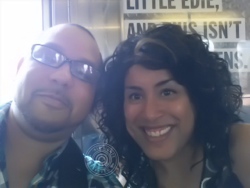This article is in memory of Charles F. Cummings, the noted Newark, NJ historian who left behind a trail for me to follow in seeking my ancestors.
I became familiar with Charles F. Cummings a few years ago. We never met in person because he passed away in 2005. But from the start, he was a friend, as Wendy Williams would say, in my head. I remember how we were introduced. I had recently located the names of my two 3rd great-aunts, the sisters of Cato Thompson, and their families. Catherine Hedden was living in 1850 with her 2 daughters and her mother, Ann. Right next door to her was her sister Mary King and her family.

I decided to google my 3rd great-aunt Mary’s husband’s name, Jacob D. King, to see if anything popped up on him. I found an article, “The Sounds of the Underground Railroad Resonate Throughout New Jersey” written by Peter Genovese in 2000 that mentioned Jacob.

I can’t tell you how PROUD I was to find this significant piece of my family history. I will be doing the happy dance for the rest of my life. LOL I have to thank Charles for documenting this.
When I first learned that both my 3rd and 4th great-grandfathers were well off in the early 1800s, I wanted to know about what type of men they were. Finding out that Cato was trained by Jacob and his brothers and that both Thomas and Cato lived right next to Jacob in 1830, meant that they both probably aided Jacob in the building of his house, as well as, the harboring of fugitive slaves on the road to freedom. Thomas Thompson was a well-respected coachman after all.
After reading this quote, I wished that Charles F. Cummings was alive so I could ask him all the questions I wanted to know about Jacob. That could not happen obviously. I reckoned that the next best thing I could do was to read his books to learn about Newark’s history.
One day, when I was at the New Jersey Historical Society, accompanied by my friend Dee Dee Roberts, President of the New Jersey Chapter of AAHGS, I came across his book, A History of Newark, 1666-2002. In his book, there were two articles that pertained to African-Americans in Newark. One article was titled, “Slavery in New Jersey: A Shame that Spanned 3 Centuries,” and it detailed slavery in New Jersey. On the 2nd page of the article, I came across this photo:

Woohoo again!Slaves’ Haven! Now, I had a picture of Jacob’s house in 1937. His house stayed in his family for 106 years. As an FYI, Rutgers University, in downtown Newark, was built over the 70 Warren St. location. Thank you, Charles, for including this photo in your book. I did another happy dance in front of Dee Dee then I immediately let Andrea know of my find.
I then came across another Cummings article in the same book, “Blacks in New Jersey: The Journey Towards Economic Freedom.” This article made reference to my 4th great-grandfather, Thomas Thompson.

Cummings mentioned Thomas Thompson (though he referred to him as Thompson Thompson) as being “the wealthiest man of color,” according the 1821 Newark Tax Ratable. I was able to confirm his information by looking at the 1821 Tax Ratable.

Cummings also listed a number of other Free Blacks in Newark. Over the past couple of years, Andrea and I have been documenting the links between these families via marriages and community building institutions, like the founding of churches, schools, anti-slavery societies, Masonic lodges, etc. We have also researched the early Black abolitionist activities of this same Free Black community.
I had told someone once that my ancestors were from Newark. They then asked me, “Did your family come after the 1967 riots?” I said, “No.” The next questions was, “So they came up from the South after World War I?” Again, I answered, “No.” I finally had to tell them that we have been in Newark probably since it’s founding. In fact, we are still there. I have a cousin whose law office is on Academy St. in downtown Newark —- on the same street where our ancestors lived in Newark in the late 1700s.
Charles didn’t know it, but as a friend, he has tipped me off about, not only my family history, but also about early Black Newark. He left clues for me and Andrea to follow up on and we have. In the coming months, I will be writing about my ancestors and this early Free Black community in early 19th century Newark. It is my goal to put early Black Newark back on the map as these African-Americans deserve to be remembered.































